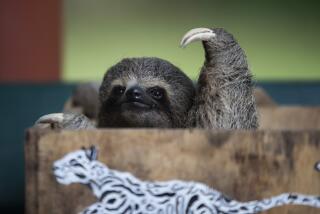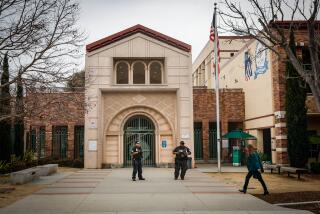Misapplication of Computers at Schools Is Stifling Creativity
- Share via
“My drawing isn’t good enough,” my daughter scoffed when I suggested that she include in her report her own illustration of the San Buenaventura Mission. “I’ll get a picture from the Internet; those are better.”
I’ve dreaded the day when my daughter would strive to color inside the lines, applying all the “right colors” to the houses and people. Now, as she finishes her last year of elementary school, the resignation to “the right way” has duly occurred, quietly, almost imperceptibly.
Blue people with six fingers who live in pink spheres no longer hang upon my refrigerator door. She now knows what is real; she’s learned it in school.
What is it about education that causes so many of us to despise our own creative work? How do I as a teacher instill in my students an appreciation for excellence while at the same time helping them to love and value their own less than perfect creations? How do I help them develop an admiration for Shakespeare’s greatness without making them feel as though their own works are insignificant by comparison?
In exposing our children to the masters it is not our intention to suggest that everyone must be a Van Gogh to paint, or a Placido Domingo to sing, or a Toni Morrison to write. Works of genius deserve to be admired, but they should inspire us to create, not refrain from creating. Yet often after we receive formal education we value our own artistic endeavors less, resigning ourselves to appreciate only the works of professionals.
Contributing to this attitude is the continued misapplication of computers in our schools. Students often feel that they must give every report and class project that computer polish. Unfortunately, this dependence on technology contributes to a disturbing rise in plagiarism. A few months ago, a student in my creative writing class confessed that many of my students had turned in stories they “got off the Internet.” Some had even hand-copied the stories, adding mistakes to help them masquerade as rough drafts.
Such pilfering is more than just proof of student laziness. It is further evidence that many students no longer enjoy the process of creating their own art because they have been told too many times that its not worth the effort--it doesn’t make the grade.
Instead, students opt to embellish their reports not with their own attempts at calligraphy but with fancy computer fonts. Instead of drawing their own pictures or taking their own photos, they cut and paste clip art. In essence, they borrow other people’s work, and they get good grades in the process.
This borrowing from others is especially encouraged in the latest craze in our schools for Power Point presentations. Although these presentations can be technically very polished, they amount to nothing more than cutting and pasting together other people’s work into a glorified slide show. It is no wonder that students jump from these cut-and-paste projects into downright plagiarism. If they can receive an A for a glossy report full of cut and pasted material from the Internet, then why not just lift an entire work?
Although teaching computer-generated presentation skills may be appropriate in a computer class, I believe it has no place in a humanities course where students should be challenged to create their own artistic works, works that uniquely reflect the world they are in the process of discovering.
Homemade reports, like homemade cakes, are so much tastier even though they might not look as fancy.
It is in adding each generation’s unique insights to our collective body of knowledge that we progress. How will I learn to see our beautiful old San Buenaventura Mission afresh if the next generation doesn’t draw it anew? What colors will fade, what music will be muted, what poems will never be heard and what stories never told if education is reduced to a cut-and-paste affair? To be a good collage artist, you must be an artist first. That’s the difference between reconception and copying.
Physicists tell us that we are the product of several generations of stars, expanding, exploding, condensing and cooling--billions of years in the making. Could it be that my daughter’s art (and yours) is evidence of this marvelous universe becoming aware of itself--a creation capable of creating?
It’s time to break out the crayons. Worlds visible and invisible await.
More to Read
The biggest entertainment stories
Get our big stories about Hollywood, film, television, music, arts, culture and more right in your inbox as soon as they publish.
You may occasionally receive promotional content from the Los Angeles Times.










